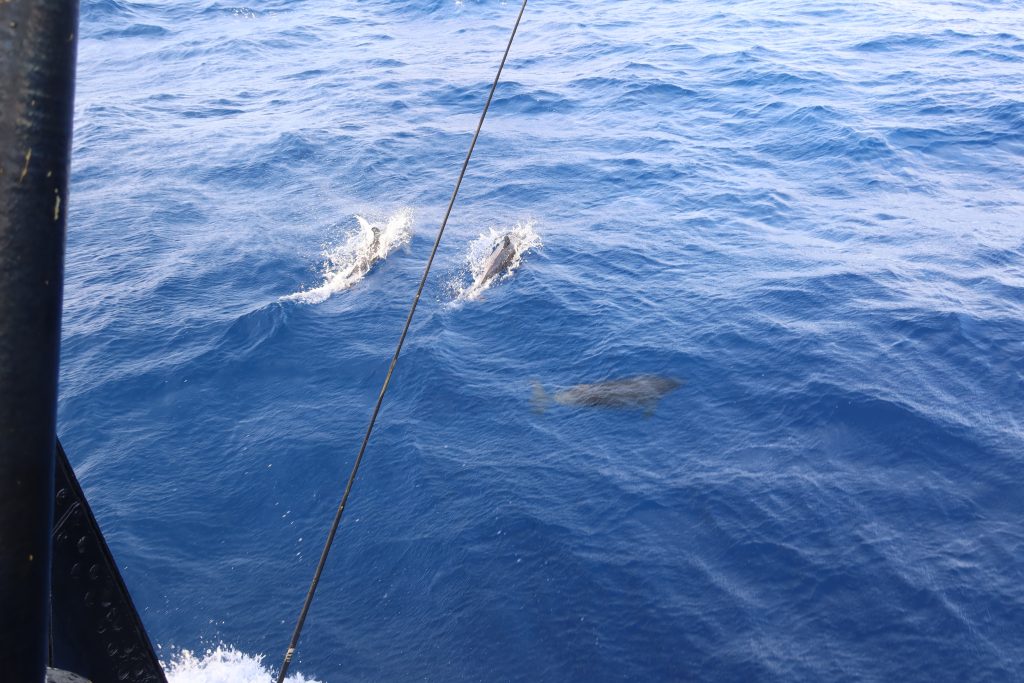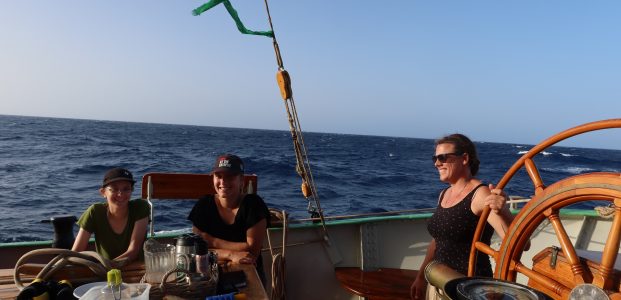Reading: The Riddle of the Sands (Erskine Childers)
Weather: Trade winds continue but shift to the NE a bit – N-NE 4 and hazy
Thought for the day: Why is it so difficult to take a good photo of a dolphin?
Evening meal: Roast pork, cauliflower cheese and salad
Course: On the morning watch between 235oC – 270oC, gybed at midday and making 190oC directly towards new waypoint at equator
Distance covered: At 1200 we had done 768 miles, 1,219miles to the equator
Flying fish headcount: More carnage ….. Lost count but probably 25 or so dead and only a few saved
This morning’s watch was frustrating. The wind kept dropping a little and shifting more towards the NE. As we were on starboard gybe, this meant that at times, to keep the boat going, we had to head up to virtually a westerly course. Now even my limited global geography tells me that at this stage, west is not a good direction! However, Jet was happy with this …. She downloads the latest weather reports through Sailmail and an Iridium phone and uses OpenCPN to display the GRIB file relative to course and heading. She showed me this and the reason why she didn’t mind the westerly heading was clear. A relative calm patch off the Cape Verde Islands meant trying to avoid them, so the original waypoint 50 miles off has been abandoned in favour of a new one on the equator about 100 miles off Brazil. Heading a little more west should keep us away from this calm and, though the wind is likely to drop a little, the forecast suggests holding the breeze all the way through the ITCZ. This may be wishful thinking though!
At the watch change at midday though we gybed. It is much simpler to type this than do it. A gybe requires military-grade planning and each step has to be done in the correct sequence. Head up slightly, take off the all the preventers, sheet in main, mizzen and staysail and lock them off. Make up the running backstay that was to leeward and ease the other runner. Once everything is prepared gybe …. slowly ….. Then slowly ease everything, take up on the preventers and finally tidy the decks. Job done …. Now we can steer straight for the new waypoint just over 1,200 miles away and are still making around 8 knots – result ….
Steering the Tecla is an art – one that clearly takes time to develop in my case. The steering wheel is like a metaphor for the boat – traditional and solid and it is beautifully varnished. Behind the wheel is a large steering box and the younger element of the crew sit astride this box, legs akimbo looking forward at the compass and steering. Age means that I take a more regal, side-saddle approach to steering with both legs one side of the steering box, trying to achieve the same, but struggling. While Jet stands languidly spinning the wheel occasionally and ignoring it much of the time, I am sat on the steering box, peering intently at the compass and spinning the wheel like a demented croupier at a roulette table. My problem is timing. There are several delays inherent in the process of steering. The first is the compass – this takes time to show the change in course. The reaction to this is to spin the wheel to compensate, but this takes time to have any effect (if indeed it does!). Eventually, if you are lucky, the ship’s head starts to correct and you need to reverse the wheel, but weirdly not as much as you spun it in the first place. Add into this the delays in the neurons firing in my brain to make the right decision about what to do and you have a recipe for pirouetting around the ocean like a first-round failure on Strictly Come Dancing. The net result is that I am often 10-15o off the course on either side, adding extra miles to our distance logged! The waves just add further complications into this mix and frequently they start pushing you exactly the way you didn’t want to go, just adding to the demented spinning of the wheel that is going on.
Getting all this right is important as it turns out that in 1915, when she was built, there were no autopilots and no-one has fitted one since. So, we are hand steering all the way! To compensate though, in the middle of the watch, we did see dolphins. I first saw one jumping right out in the distance and they then headed across and played around the bow for five minutes or so. They were apparently common dolphins, but seeing them is far from a common experience and always improves a day – something about the naïve joy they seem to derive from playing around the bow wave cannot help but lift your spirits and stay with you for hours afterwards.


